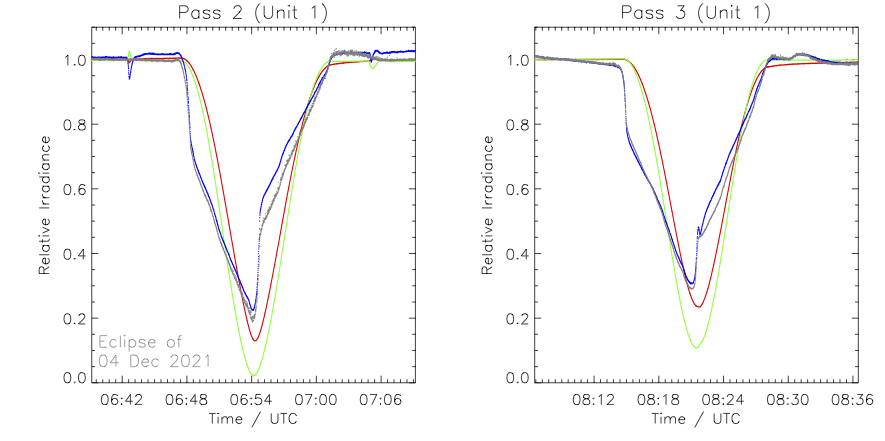Main menu
You are here
December 4, 2021: Antarctic Solar Eclipse
Tue, 11/30/2021 - 21:20 — Elke D'Huys
 Let’s hope the penguins have their eclipse glasses ready. They will form most of the crowd in the Antarctic that will be able to witness a total solar eclipse on December 4. Fortunately, spectators in parts of southern Africa, South Australia, New Zealand and South America will see a partial solar eclipse, if the weather cooperates of course. A simulation of the eclipse path is shown below, following the eclipse from west to east at a greater speed than the Earth’s rotation (giving the false impression that the Earth is spinning in the wrong direction).
Let’s hope the penguins have their eclipse glasses ready. They will form most of the crowd in the Antarctic that will be able to witness a total solar eclipse on December 4. Fortunately, spectators in parts of southern Africa, South Australia, New Zealand and South America will see a partial solar eclipse, if the weather cooperates of course. A simulation of the eclipse path is shown below, following the eclipse from west to east at a greater speed than the Earth’s rotation (giving the false impression that the Earth is spinning in the wrong direction).
 Let’s hope the penguins have their eclipse glasses ready. They will form most of the crowd in the Antarctic that will be able to witness a total solar eclipse on December 4. Fortunately, spectators in parts of southern Africa, South Australia, New Zealand and South America will see a partial solar eclipse, if the weather cooperates of course. A simulation of the eclipse path is shown below, following the eclipse from west to east at a greater speed than the Earth’s rotation (giving the false impression that the Earth is spinning in the wrong direction).
Let’s hope the penguins have their eclipse glasses ready. They will form most of the crowd in the Antarctic that will be able to witness a total solar eclipse on December 4. Fortunately, spectators in parts of southern Africa, South Australia, New Zealand and South America will see a partial solar eclipse, if the weather cooperates of course. A simulation of the eclipse path is shown below, following the eclipse from west to east at a greater speed than the Earth’s rotation (giving the false impression that the Earth is spinning in the wrong direction).As always, the LYRA and SWAP instruments on PROBA2 are ready to observe this spectacle from their sun-synchronous orbit around Earth. Due to the high velocity at which the satellite orbits, the instruments onboard will be able to observe as much as three occultations, and one more passage of the Moon in the SWAP field-of-view. Also for PROBA2 the eclipse will almost be a total one: at the second occultation (that is a passage of the Moon in front of the Sun) more than 95% of the solar disk will be covered! All four passages of the Moon before SWAP’s eye are shown in the simulation below.
LYRA Observations
As for all eclipses, LYRA activated one of its backup units, which acquired in parallel with the nominal unit. The instrument monitored the progressive extinction of the solar light in its channels that observe in the ultraviolet (red and green curves) and extreme ultraviolet (black and blue curves). As can be seen in the figure below, the extreme ultraviolet curves have an asymmetric, slightly twisted profile. This is caused by the fact that the Sun, in those wavelengths, doesn't emit uniformly over its surface. Active regions appear much brighter than the rest of the solar disk. The distortion of the extreme ultraviolet curves is caused by the sudden occultation of an active region located at the right limb of the Sun. Interestingly, that active region produced several flares of moderate amplitude on the eclipse day. LYRA observations are available in the event directory .
.

SWAP observations
We made high cadence observations with SWAP and produced our typical sets of calibrated PNG images (with logos and timestamp, with timestamp only, and without logos or timestamp), as well as movies of the event. All the movies and images of the eclipse are collected in dedicated directories on our webpages. The event directory also contains a specially selected SWAP image to promote the eclipse. This is the image with the largest part of the Sun occulted by the Moon.
Data Use Policy
All PROBA2 images and movies used in outreach and the media should be credited to "ESA/ROB". Additional information about the terms of use for PROBA2 data is available on the PROBA2 website.
Contacting the PROBA2 Team
All requests for media comments, data assistance, or planning requests can be directed to the SWAP and LYRA teams via swap_lyra@oma.be.
